Introduction
In today’s dynamic business landscape, mergers, acquisitions, and divestitures have become commonplace. During these transformative events, one critical process that organizations undertake is an IT carve-out. This article provides an in-depth understanding of IT carve-outs, focusing on data carve-outs and the challenges associated with SAP carve-outs. Additionally, it offers a comprehensive checklist to guide you through a successful IT carve-out process.
Understanding IT Carve-Outs
An IT carve-out is the process of separating a portion of an organization’s IT infrastructure and assets to establish a separate entity or enable a smooth transition to new ownership. It involves disentangling systems, applications, data, and networks while ensuring business continuity. IT carve-outs are complex endeavors that require meticulous planning, coordination, and technical expertise.
The Carve-Out Process
The carve-out process typically involves several stages, starting from pre-carve-out planning to post-carve-out support. Each stage demands careful attention to detail and effective communication to minimize disruption and ensure a seamless transition. Let’s explore the key steps involved in an IT carve-out.
Key Considerations for Data Carve-Out
One crucial aspect of an IT carve-out is data separation. Data carve-out entails identifying and segregating data specific to the carved-out entity, ensuring data integrity, and complying with data privacy regulations. This section delves into the essential considerations when handling data during a carve-out process. For organizations utilizing SAP as their enterprise resource planning (ERP) system, a carve-out involving SAP landscapes poses unique challenges. This section discusses the intricacies of SAP carve-outs, including data dependencies, system configurations, and licensing considerations.
Creating an IT Carve-Out Checklist
To ensure a smooth and successful IT carve-out, it is crucial to develop a comprehensive checklist. This checklist will guide you through each step of the process, addressing potential risks and providing mitigation strategies. Let’s dive into the key components of an effective IT carve-out checklist.
Archive Your Legacy systems with AvenDATA
Step 1: Defining the Scope
Clearly defining the scope of the carve-out is the foundation of a successful IT separation. This step involves identifying the specific systems, applications, data, and infrastructure that will be carved out and establishing the desired end-state.
Step 2: Assessing Dependencies
Understanding the interdependencies between IT systems is vital to avoid any unforeseen disruptions. This step focuses on conducting a thorough assessment of technical and operational dependencies to ensure a seamless carve-out process.
Step 3: Identifying Risks and Mitigation Strategies
Risk identification and mitigation are integral parts of any carve-out plan. This step involves identifying potential risks, such as data loss, system incompatibility, and apologies for the incomplete response. By conducting a comprehensive risk assessment, you can proactively address potential challenges and implement appropriate safeguards.
Step 4: Planning the Data Migration
Data migration is a critical aspect of an IT carve-out. This step focuses on developing a detailed plan for extracting, transforming, and loading data from the existing systems to the carved-out entity’s infrastructure. Careful planning and execution are necessary to ensure data integrity and minimize downtime.
Step 5: Communication and Change Management
Effective communication is essential throughout the carve-out process to keep stakeholders informed and manage expectations. This step involves developing a communication plan that outlines the key messages, channels, and target audiences. Additionally, change management strategies help employees adapt to the changes resulting from the carve-out.
Step 6: Testing and Validation
Thorough testing is crucial to verify the functionality and performance of the carved-out IT infrastructure. This step includes comprehensive testing of systems, applications, data integrity, and security measures. Validating the carve-out’s success ensures a smooth transition to the new entity.
Step 7: Go-Live and Post-Carve-Out Support
The final step involves executing the carve-out plan and transitioning to the new IT environment. Go-live activities include deploying the separated systems, ensuring user access, and providing post-carve-out support to address any issues or challenges that may arise.
Best Practices for a Successful IT Carve-Out
To enhance the likelihood of a successful IT carve-out, it is essential to follow best practices. This section highlights some key recommendations, such as engaging experienced professionals, documenting processes, conducting thorough due diligence, and maintaining open lines of communication.
Conclusion In conclusion, an IT carve-out is a complex process that requires meticulous planning, coordination, and technical expertise. Whether it involves data carve-outs or SAP carve-outs, organizations must follow a systematic approach to ensure a smooth transition and minimize disruption. By utilizing an IT carve-out checklist and adhering to best practices, organizations can streamline the process and maximize the chances of a successful carve-out. AvenDATA specializes in legacy system archiving, application and systems decommissioning, and carve-outs, setting new standards in terms of speed, cost efficiency, functionality, and reliability.






Comments